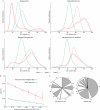Environments shape the nucleotide composition of genomes
- PMID: 16200051
- PMCID: PMC1369203
- DOI: 10.1038/sj.embor.7400538
Environments shape the nucleotide composition of genomes
Abstract
To test the impact of environments on genome evolution, we analysed the relative abundance of the nucleotides guanine and cytosine ('GC content') of large numbers of sequences from four distinct environmental samples (ocean surface water, farm soil, an acidophilic mine drainage biofilm and deep-sea whale carcasses). We show that the GC content of complex microbial communities seems to be globally and actively influenced by the environment. The observed nucleotide compositions cannot be easily explained by distinct phylogenetic origins of the species in the environments; the genomic GC content may change faster than was previously thought, and is also reflected in the amino-acid composition of the proteins in these habitats.
Figures


Similar articles
-
On the organizational dynamics of the genetic code.Genomics Proteomics Bioinformatics. 2011 Apr;9(1-2):21-9. doi: 10.1016/S1672-0229(11)60004-1. Genomics Proteomics Bioinformatics. 2011. PMID: 21641559 Free PMC article.
-
Evolution of complete proteomes: guanine-cytosine pressure, phylogeny and environmental influences blend the proteomic architecture.BMC Evol Biol. 2013 Oct 3;13:219. doi: 10.1186/1471-2148-13-219. BMC Evol Biol. 2013. PMID: 24088322 Free PMC article.
-
Prokaryotic nucleotide composition is shaped by both phylogeny and the environment.Genome Biol Evol. 2015 Apr 9;7(5):1380-9. doi: 10.1093/gbe/evv063. Genome Biol Evol. 2015. PMID: 25861819 Free PMC article.
-
Lessons from the genomes of extremely acidophilic bacteria and archaea with special emphasis on bioleaching microorganisms.Appl Microbiol Biotechnol. 2010 Oct;88(3):605-20. doi: 10.1007/s00253-010-2795-9. Epub 2010 Aug 10. Appl Microbiol Biotechnol. 2010. PMID: 20697707 Review.
-
The impact of genomics on research in diversity and evolution of archaea.Biochemistry (Mosc). 2012 Aug;77(8):799-812. doi: 10.1134/S0006297912080019. Biochemistry (Mosc). 2012. PMID: 22860902 Review.
Cited by
-
A comprehensive survey of integron-associated genes present in metagenomes.BMC Genomics. 2020 Jul 20;21(1):495. doi: 10.1186/s12864-020-06830-5. BMC Genomics. 2020. PMID: 32689930 Free PMC article.
-
Genomic Legacies of Ancient Adaptation Illuminate GC-Content Evolution in Bacteria.Microbiol Spectr. 2023 Feb 14;11(1):e0214522. doi: 10.1128/spectrum.02145-22. Epub 2022 Dec 13. Microbiol Spectr. 2023. PMID: 36511682 Free PMC article.
-
Different clustering of genomes across life using the A-T-C-G and degenerate R-Y alphabets: early and late signaling on genome evolution?J Mol Evol. 2007 Apr;64(4):448-56. doi: 10.1007/s00239-006-0178-8. Epub 2007 Mar 19. J Mol Evol. 2007. PMID: 17479343
-
Variation in Release Factor Abundance Is Not Needed to Explain Trends in Bacterial Stop Codon Usage.Mol Biol Evol. 2022 Jan 7;39(1):msab326. doi: 10.1093/molbev/msab326. Mol Biol Evol. 2022. PMID: 34751397 Free PMC article.
-
TACOA: taxonomic classification of environmental genomic fragments using a kernelized nearest neighbor approach.BMC Bioinformatics. 2009 Feb 11;10:56. doi: 10.1186/1471-2105-10-56. BMC Bioinformatics. 2009. PMID: 19210774 Free PMC article.
References
-
- Bentley SD, Parkhill J (2004) Comparative genomic structure of prokaryotes. Annu Rev Genet 38: 771–792 - PubMed
-
- Bharanidharan D, Bhargavi GR, Uthanumallian K, Gautham N (2004) Correlations between nucleotide frequencies and amino acid composition in 115 bacterial species. Biochem Biophys Res Commun 315: 1097–1103 - PubMed
-
- Delong EF (2005) Microbial community genomics in the ocean. Nat Rev Microbiol 6: 459–469 - PubMed
-
- Fickett JW (1995) ORFs and genes: how strong a connection? J Comput Biol 2: 117–123 - PubMed
-
- Foster PG, Jermiin LS, Hickey DA (1997) Nucleotide composition bias affects amino acid content in proteins coded by animal mitochondria. J Mol Evol 44: 282–288 - PubMed
Publication types
MeSH terms
Substances
LinkOut - more resources
Full Text Sources
Other Literature Sources
Miscellaneous

